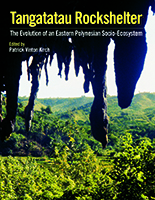Notes
Mammal bones excavated from Mangaia sites other than MAN-44.
Item record
Documentation
Vertebrate methods
Vertebrate faunal remains were systematically recovered from all excavation units and levels by sieving of sediment through nested ½-, ¼-, and ⅛-in. mesh screens. Initial sorting of bone into major categories (fish, mammal, bird, etc.) was carried out by David Steadman, who sent the sorted fish bones to Butler and the mammal bones (except for rat and fruit bat) to Kirch for further analysis. Steadman retained the rat, fruit bat, and bird bones in his laboratory (these specimens are currently housed at the Florida State Museum, Gainesville). A digital database (originally prepared in Paradox and later converted to Excel) of the fruit bat and bird bones, listing each cataloged specimen separately with identification to species and skeletal element, was prepared by Steadman; this database provides the basis for the analysis of fruit bat and bird remains from site MAN-44.
In reporting the vertebrate faunal remains from MAN-44, we use number of identified specimens (NISP) as the primary means of quantification, rather than the minimum number of individuals (MNI). This is due to the high degree of fragmentation of many of the specimens, which renders determination of MNI highly problematic. However, as Grayson (1984) demonstrated, MNI and NISP are in general highly correlated, especially when sample sizes are large. In comparing faunal assemblages from different stratigraphic zones—especially when looking at overall temporal trends—we also use concentration indices (CIs) calculated as NISP per cubic meter of deposit, which provides a sample size correction for the different volumes of sediment excavated in each stratigraphic zone.
Mammal methods
The mammal bones (excluding rats and fruit bats) were analyzed in the Oceanic Archaeology Laboratory at U.C. Berkeley in 1992–1993 by Susan Antón and Pia Anderson, then graduate students in physical anthropology and archaeology, respectively. Identification of bones to skeletal element and taxon were made by comparison to a modern pig (Sus scrofa) skeleton collected on Mangaia and to two modern, small European dog (Canis familiaris) skeletons in the collection of the Museum of Vertebrate Zoology at Berkeley. In addition to identifying the mammal bones to taxon and element, Anderson and Antón systematically observed patterns of fracturing, burning, and other modifications. These observations are included in the MAN-44 Mammal Fauna database, which, along with two unpublished manuscript reports (Anderson and Antón MS A, MS B), provided the data on which this summary of pig, dog, and human remains from MAN-44 is based.
In reporting the vertebrate faunal remains from MAN-44, we use number of identified specimens (NISP) as the primary means of quantification, rather than the minimum number of individuals (MNI). This is due to the high degree of fragmentation of many of the specimens, which renders determination of MNI highly problematic. However, as Grayson (1984) demonstrated, MNI and NISP are in general highly correlated, especially when sample sizes are large. In comparing faunal assemblages from different stratigraphic zones—especially when looking at overall temporal trends—we also use concentration indices (CIs) calculated as NISP per cubic meter of deposit, which provides a sample size correction for the different volumes of sediment excavated in each stratigraphic zone.
Reuse
Kirch, Patrick V., 2017. Mammal bones (Mangaia sites other than MAN-44). https://doi.org/10.25346/S6/SC503L
